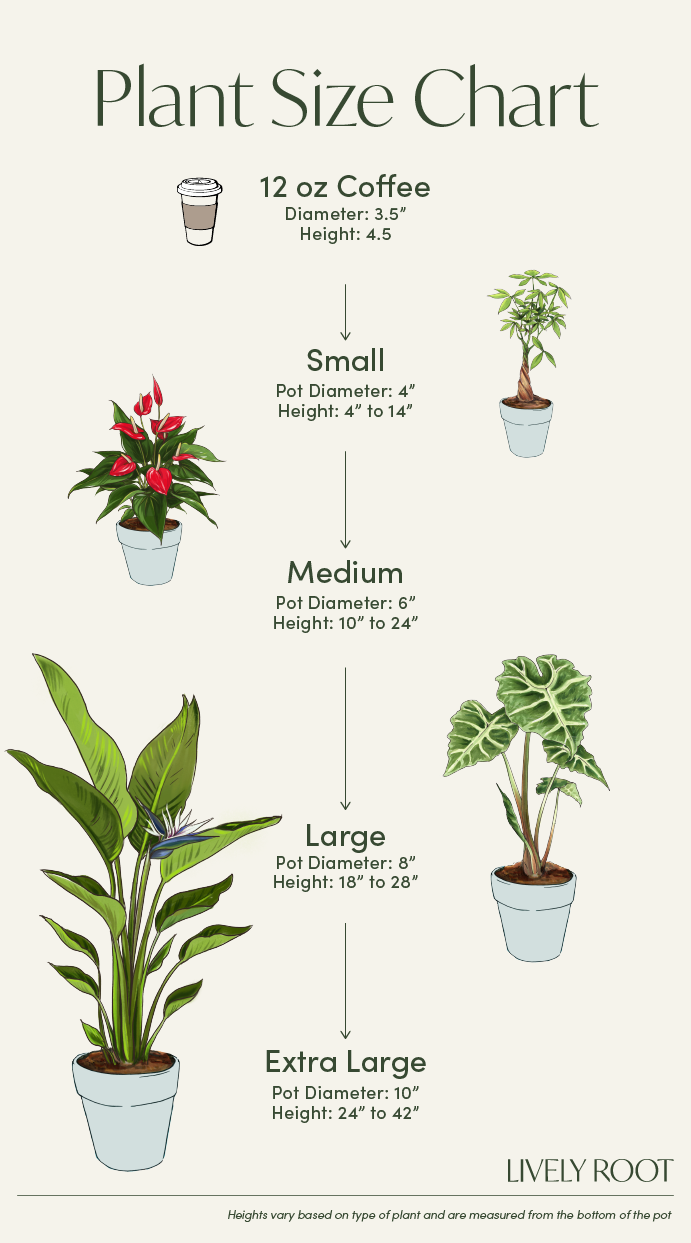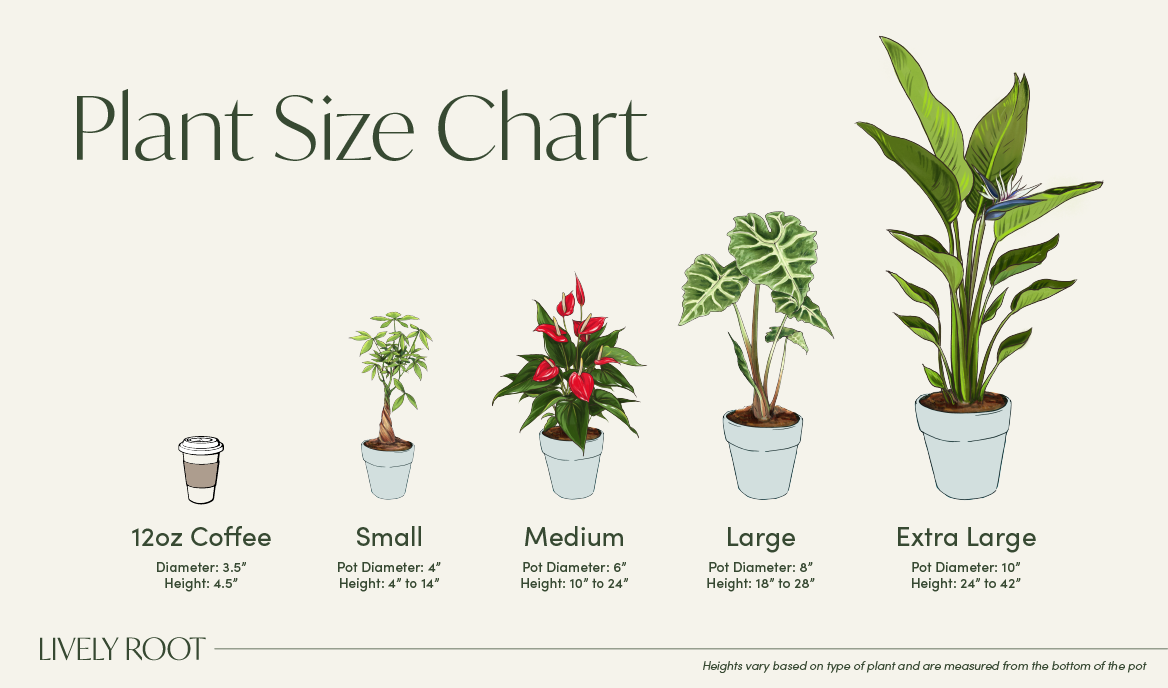

The Maranta Red Prayer Plant (Maranta Leuconeura) has their own internal clock exemplified in their daily rhythm. They lift their leaves in the evening and lower them in the morning, mimicking praying hands. The broad, oval leaves have two-color variegated spots with red veining on the top side and a reddish color on the bottom side, making them very festive to enjoy in any home or office.
Maranta Plant Care Guide & Presentation

Medium to bright indirect light. Never direct sunlight.
Use filtered, bottled, or tap water sitting 24 hours to release the chemicals and water enough to discharge out of the drainage holes. Once the water is fully drained, replace them into the cache or decorative pot. Don't let the roots sit in standing water. Keep the soil consistently moist. During winter months, reduce watering while they are in dormancy.
Enjoys medium humidity. Add a pebble tray or humidifier to keep the humidity around them. Spritz a couple times per week.
This plant likes warmer temperatures. Keep out of cold drafts.
Gardeners can grow these Prayer Plants as a ground cover in the outdoors in this plant hardiness zones 11-12.
Fertilize every two weeks during the growing season (spring and summer) by diluting a liquid fertilizer by half strength. Let the plant rest in the fall and winter.
When receiving the plant, do not re-pot immediately but wait at least 6 to 12 months or if the roots are beginning to get crowded and growing through the drainage holes.
Re-pot in the spring, using a 2" wider shallow pot. Use a well-draining, aerated indoor potting soil with perlite.
Water your plant in the old pot before transferring over and let sit an hour. Place a piece of screening at the bottom of the container over the drainage hole to the soil and allow to drain. Add soil to the bottom to elevate the root ball. Lift the plant and release the roots against the existing planter. Use a clean knife or garden trowel to wedge between the pot and the soil to loosen.
Inspect the root ball. Notice if there are any dead or rotting roots and trim off with sterile pruners. If the plant is rootbound, cut through the roots to alleviate continued encircling.
Ensure the plant is sitting about 1" below the edge of the pot to avoid water spillage. Add more soil and backfill around the sides by tamping down. Fill up to the soil line but not over.
Water thoroughly, leaving the soil damp but not soggy. If settling occurs, add more soil.
Remove any brown edges with a trim and keep the soil free of debris.
Cuttings:
To propagate this plant during the growing season, take a stem cutting in the early spring. Use a knife or sharp pruners, cut below a node closest to the end of the stem. Place the stem in a glass jar and fill them with filtered water and watch the roots grow! Replace and freshen the water each week. After the roots are several months old, add them to moistened potting soil, continue to water, and give them the bright, indirect lighting requirements. Add a clear plastic bag over the pot to retain humidity while the stem roots.
Soil propagation includes dipping the cutting in hormone stimulator and placing in prepared rich, well-draining, moist (but not soggy) soil with plenty of aeration. Keep the soil moist for approximately four weeks until roots begin to grow. You can tug slightly on the stalk to see if roots are grabbing and holding after this time. Provide their bright, indirect light to acquire the photosynthesis for growth to occur.
Division:
Remove the plant from the pot. Hold the base and turn upside down with your palm securely holding the plant. Gingerly pull the pot off the root base. Separate the plant into halves or thirds by pulling apart the roots or using a sterilized knife. Repot each in new well-draining aerated soil. Use a smaller, shallow pot for each portion. Fill each with soil, leaving an inch below the soil edge to eliminate water spillage. Water and let drain well.
Red Maranta Prayer Plant: Overview
The Red Maranta Prayer Plant (Maranta leuconeura erythroneura), or Red-Veined Prayer Plant, is prized for its eye-catching foliage. Its oval green leaves feature vivid red veins with lighter green patches, and the undersides are purple. At night, the leaves fold upward in a prayer-like motion, known as ‘nyctinasty.’
Native to Brazil and part of the Marantaceae family, this tropical plant is hardy in USDA zones 11-12. Indoors, it grows 12-18 inches tall and up to 24 inches wide. This Prayer Plant prefers bright, indirect light but tolerates low light. It requires consistent moisture, high humidity, and protection from direct sunlight, drafts, and overwatering.
This gorgeous red plant symbolizes gratitude and devotion and reflects its spiritual nature with its nightly leaf movement. It’s also non-toxic to pets, making it safe for homes with cats or dogs, though ingestion may cause mild digestive discomfort.
Maranta Leuconeura: Benefits
- Strong air-purifying properties, improving indoor air quality
- Non-toxic to pets, making it safe for homes with cars and dogs
- Aesthetic value with striking, colorful foliage
- Symbolizes gratitude and devotion, adding a peaceful, spiritual vibe to any space
Maranta Leuconeura: Care Guide
The Maranta leuconeura, or Red-Veined Prayer Plant, is a moderately easy plant to care for, ideal for those who can maintain a balance of moisture and humidity. With the right conditions, this tropical beauty thrives indoors.
Watering & Humidity
Maranta plants love moisture, so keep the soil evenly moist but not waterlogged. Water when the top inch of soil feels dry, and use filtered or distilled water to prevent leaf browning from minerals. High humidity (50% or more) is essential. Use a humidifier or mist the plant regularly to mimic its tropical origins.
Light & Temperature
Bright, indirect light is best for this plant. Avoid direct sunlight, which can scorch the leaves, or too little light, which can dull its vibrant colors. Maranta plants prefer temperatures between 65–80°F (18–27°C) and should avoid cold drafts and sudden temperature changes.
Soil & Repotting
Use a well-draining potting mix that retains moisture but doesn’t stay soggy. A mix of peat, perlite, and regular potting soil works well. Repot your Red Maranta plant every 2–3 years in spring to refresh the soil and prevent root-bound issues.
Feeding, Pruning & Cleaning
Feed the Maraanta Prayer plant with a balanced liquid fertilizer every 4–6 weeks during the growing season (spring to early autumn). Prune yellow or damaged leaves to keep the plant healthy and encourage new growth. Also, gently wipe the leaves with a damp cloth every few weeks to remove dust and improve their ability to photosynthesize.
Propagation & Common Issues
Marantas can be propagated through division during repotting. You can also root stem cuttings in water and soil as alternative prayer plant propagation methods. Watch out for common issues like leaf curling (due to low humidity), brown tips (from overwatering or poor water quality), and pest infestations like spider mites, which thrive in dry conditions.
Red Maranta Plant: Placement, Companion & Alternative Plants
The Maranta Red Prayer Plant is a versatile addition to various indoor spaces. It thrives in conditions that cater to its moisture-loving nature, making it an excellent choice for enhancing your home's aesthetic appeal and ambiance.
Best Locations & Uses
- The Maranta plant's ability to thrive in lower light conditions makes it perfect for adding a touch of greenery to bedrooms.
- It is a great gift for plant lovers, especially those who appreciate its vibrant foliage and symbolic meaning.
- Red Maranta is safe for households with cats and dogs, making it an excellent plant for pet owners.
- It thrives in bathrooms or other humid spaces where it can enjoy the moisture.
- The Maranta Prayer plant is suitable for use on covered porches or patios in warmer climates, where it can benefit from outdoor humidity and warmth.
Companion Plants
Pairing the Red Maranta with other houseplants can enhance its aesthetic and environmental benefits. Here are three great companions:
- Calathea Orbifolia (Calathea orbifolia): With its large, round leaves and similar care requirements, the Calathea orbifolia complements the Maranta's foliage and thrives in similar humidity levels.
- Variegated Spider Plant (Chlorophytum comosum): The Variegated Spider Plant is a low-maintenance plant that shares the Maranta's preference for indirect light and helps improve air quality.
- Boston Fern Plant (Nephrolepis exaltata): The Boston Fern adds a lush, feathery texture and thrives in high humidity, making it an ideal companion for maintaining a humid environment.
Alternative Plants
If you're considering alternatives to the Red Prayer Plant, here are three pet-safe options that flourish in similar environments:
- Calathea Rattlesnake (Calathea lancifolia): Known for its striking leaf patterns and similar care needs, the Calathea Rattlesnake provides a vibrant look and thrives in similar indoor conditions.
- Zebra Plant (Aphelandra squarrosa): Featuring bold, striped leaves and moderate care requirements, the Zebra Plant adds a unique touch while being safe for pets.
- Areca Palm Indoor Tree (Dypsis lutescens): With its feathery, arching fronds and air-purifying properties, the Areca Palm offers a tropical feel and easy care, perfect for bright, indirect light.
Order Your Red Maranta Prayer Plant From Lively Root Today
Enhance your home with the vibrant and pet-friendly Red Maranta! Order yours from Lively Root today, and enjoy its beauty and benefits in your home or office!








































